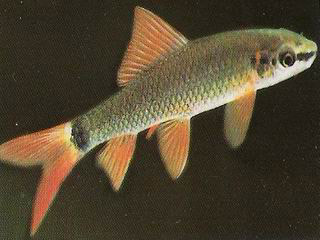Shark - Rainbow
Red Fin Shark Scientific Name: Epalzeorhynchos (Labeo) frenatus
Fri, 18th April, 2025 - 8:04 pm GMT
Sponsor Ads:

Alternative Name
Red Fin Shark Scientific Name: Epalzeorhynchos (Labeo) frenatusBasic Info
Rainbow Sharks often grow to mature lengths of six inches (15 centimeters). The body is shaped similar to that of a true shark, rather flattened laterally and thick. The distinct fins are reddish in color, while the rest of the Rainbow Shark's body is a dark brownish-black color.
Health
Rainbow Sharks do well in water temperatures between 72 and 80 degrees Fahrenheit (22 and 26.6 degrees Celsius). The pH level should remain between 6.5 and 7.5. Decorations should be present both for territorial marking and hiding. Rainbow Sharks should not be kept with other members of their species. They are often territorial with any fish in their enclosure, and should only be kept with fish of roughly equal size and temperament. Rainbow Sharks can be fed live or frozen bloodworms, glass worms, or brine shrimp. They can be offered frozen vegetable diets in addition to fresh zucchini, spinach, algae, or lettuce. Live fish, tubifex worms, and frozen plankton are all commonly offered to Rainbow Sharks. Many of these fish are also maintained successfully on flake, pellet, or freeze-dried foods. The vegetable portions of the Rainbow Shark's diet are important, particularly for juveniles. Without plant matter, stunted growth and poor coloration can occur. Breeding Rainbow Sharks can be sexed by the observation of their dorsal fins. A female's will drop sharply in a right angle, while a male's will taper to a point. Also, males have anal fins marked with black lines. Because they are so intolerant of conspecifics, Rainbow Sharks are not often successfully bred in captivity. Perhaps because of the size and opportunity for hiding, breeding has been more successful in outdoor pond settings than in indoor aquariums. Sometimes, feeding Rainbow Sharks high protein diets of brine shrimp and tuna, and achieving a 25 percent water change in the breeding tank over a two hour period, will induce spawning.Habitat
Fresh water fishBehavior
The Rainbow Shark is a lovely fish that is a great favorite with many aquarists. With their pretty, muted colorations, and their useful algae eating habit, the Rainbow Shark can make a nice addition to community tanks containing larger fish. Usually, Rainbow Sharks remain in the middle to bottom levels of aquariums. Most do not tolerate other Rainbow Sharks and must be kept singly. If other fish are present in the tank, they should be of roughly equal size and temperament to the Rainbow Shark in order to avoid stress and bullying. The Rainbow Shark is quite territorial, and decorations in its enclosure will help it to create territorial boundaries. Despite its tendencies to eat smaller fish, the Rainbow Shark is in essence a type of algae eating minnow, not of the shark family.Origin
ThailandHistory
The Rainbow Shark is native to Thailand and Indonesia. Confusion over the taxonomic classification of this fish has been particularly rampant in recent years, when the fish was moved from the genus Labeo to Epalzeorhynchos. The species name, commonly seen as frenatus, has also been disputed, with some claiming that the true species name for a Rainbow Shark is erythrurus.Common Foods
N/ASponsor Ads:
A bird in the hand is worth about three Kleenex. -- Unknown
Shark - Rainbow
Coded by: BGID® | ALL RIGHTS RESERVED Copyright © 2000-2025
Disclaimer | Privacy | Report Errors / Contact | Credits
















